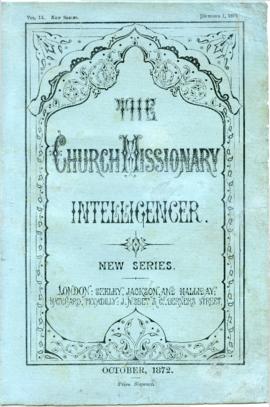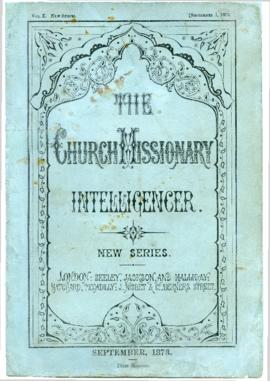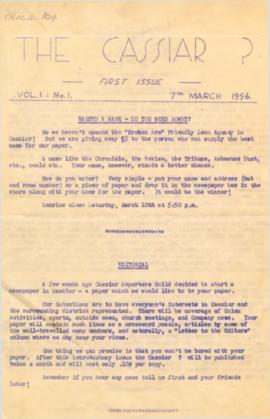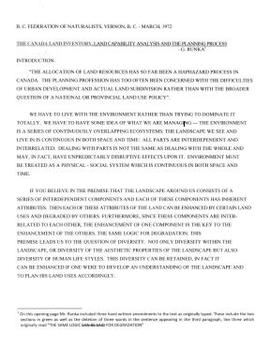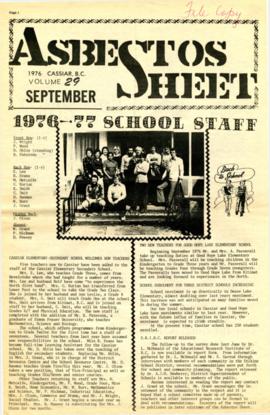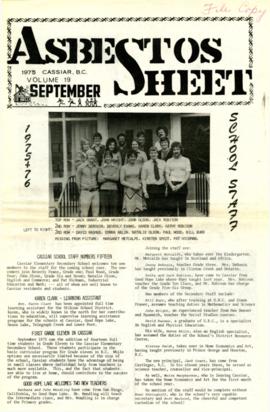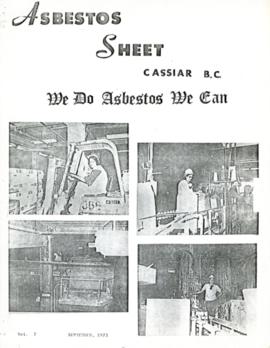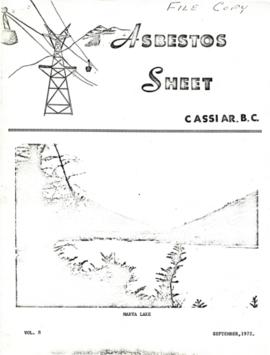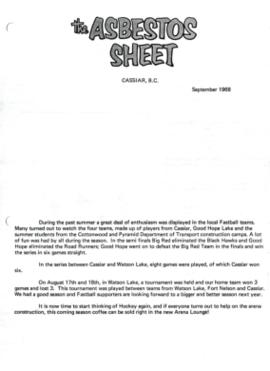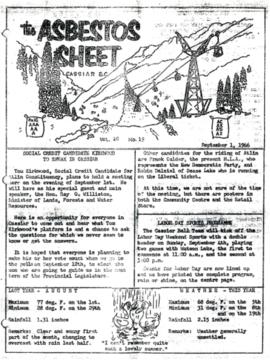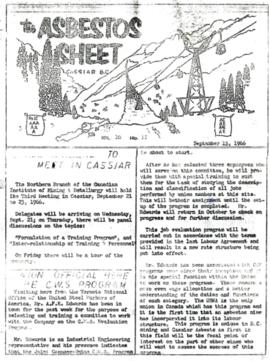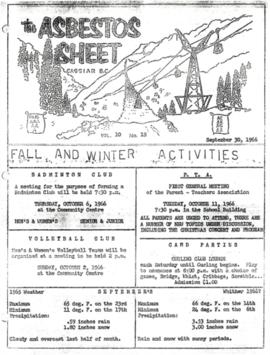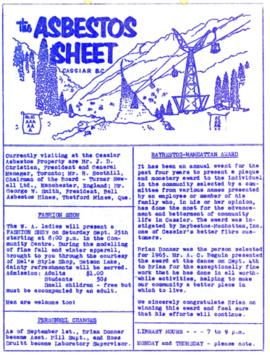File contains timber sale contracts and related correspondence between the Department of Lands and Forests and the Fichtner Lumber Company Limited.
File contains timber sale contracts and general correspondence between the Department of Lands and Forests and the Fichtner Lumber Company.
File contains timber sale contracts, logging inspection reports, and related correspondence between the Department of Lands and Forests and the Fichtner Lumber Company Limited.
File contains general correspondence and timber sale contracts between the Department of Lands and Forests and the Fichtner Lumber Company Limited.
File contains timber sale contracts and logging inspection reports between the Department of Lands and Forests and the Fichtner Lumber Company Limited.
File contains logging inspection reports, timber sale contracts, and general correspondence between the Department of Lands and Forests and the Fichtner Lumber Company Limited.
File contains timber sale contracts, logging inspection reports, and related correspondence between the Department of Lands and Forests and the Fichtner Lumber Company Limited.
File contains timber sale contracts and general correspondence between the Department of Lands and Forests and the Fichtner Lumber Company Limited.
File contains timber sale contracts and logging inspection reports between the Department of Lands and Forests and the Fichtner Lumber Company.
File contains timber sale contracts, logging inspection reports, and related correspondence between the Department of Lands and Forests and the Fichtner Lumber Company Limited.
File contains timber sale contracts from the Department of Lands and Forests to the Fichtner Lumber Company Limited.
File contains timber sale contracts and logging inspection reports for Eagle Lake Sawmill from the Department of Lands and Forests.
File contains photocopies of timber sale contracts and general correspondence regarding timber sales between the Department of Lands and Forests and surrounding mills of the Aleza Lake Experiment Station.
File consists of a contribution to a workshop given by Gary Runka entitled "The Use of Bio-Physical Information - BC Land Commission Overview". Includes excerpts from the Proceedings from the Workshop on Ecological Land Classification in Urban Areas, Canadian Committee on Ecological Land Classification, 23 & 24 Nov. 1976, Toronto.
Commentary on this speech by Barry Smith of the Ministry of Agriculture and Lands:
"Besides a copy of the speech, the package includes + a letter from Ed Wiken of the Canada Committee on Ecological (Bio-Physical) Land Classification to G.G. Runka dated October 1977 and a "Notice of Publication" + 1 copy of the published paper entitled "The Use of Biophysical Information - B.C. Land Commission Overview" by G.G. Runka, Chairman, B.C. Land Commission.
This speech was given to a workshop in Toronto and very closely resembles and reads like a draft of the published (polished) 3 page paper.
GGR remarks that:
"As you can appreciate, we often find ourselves in the centre of politically sensitive issues. For this and other reasons, the Commission might be described as being on the "firing line" with regards to the use of bio-physical information - it is the basis of our agricultural zoning and the basis of our everyday decisions regarding applications under the Act and changes to the Agricultural Land Reserve."
The speech and paper provide an important overview on the role of the Canada Land Inventory (CLI) agricultural capability ratings in the designation of the ALR and is especially important because the paper is written by the individual who was central to both the development of the CLI in B.C. and designation of the ALR.
The published paper forms pages 141 to 143 of the 167 page proceedings of the 1976 workshop."
File contains a 1921 original copy of "The Talking Trees and Canadian Forest Trees" by James Lawler and the Department of the Interior Forestry Branch.
Item is an original "The Spatsizi and Stikine Rivers: Mainstem System Evaluations of Fishery and Recreation Values" by E.J. Osmond-Jones, Environmental Management Division, B.C. Parks Branch. Includes original photographic prints pasted into the report.
File consists of a speech given by Gary Runka entitled "The Rural-Urban Continuum: Tough Land Use Choices Ahead" for the Vernon Rotary Rural-Urban Day.
Commentary on this speech by Barry Smith of the Ministry of Agriculture and Lands:
"This speech / paper does cover some old ground dealt with in other speeches but is nicely brought together here.
GGR outlines several competing land uses and uses agriculture as a starting point in setting the stage by noting that there are just 74,400 food producers and 2,400,000 other British Columbians.
An emphasis is placed on communications, especially since most planners and politicians are overwhelmingly urban oriented. When involved with rural planning it is important to understand the rural side of the fence and look back at the urban area rather than the other way around. This means "understanding the natural characteristics of the land resource and its ecosystems."
Seven issues are considered:
- Short-sighted premises - the supply of land is limitless and the individual has the right to use his
land as he wishes without affecting others; - The interdependence of man within natural systems is not fully appreciated;
- Reluctance of rural people to accept planning programs;
- Institutions and organizations reflect rural reality;
- Sprawl is not confined to urban areas and when it affects the rural area it can be a large problem;
- The dilemma of wanting data to make good land use decisions, but while we wait for information,
bad decision are being made; and - What is politically palatable?
The speech ends with the need for rural and urban communities to be mutually supportive. While farmland preservation isn't central to this speech the rural resource and planning theme is relevant."
Item is an original issue of Forest Management Notes on "The Results of Stand Treatment in the White Spruce Alpine Fir Type of the Northern Interior of British Columbia" by D.R. Glew.
Item is an issue of "Forest Management Notes" on "The Results of Stand Treatment in the White Spruce Alpine Fir Type of the Northern Interior of British Columbia" by D.R. Glew.
Item is a report entitled "The Result of Stand Treatment in the White Spruce-Alpine Fir Type of the Northern Interior of British Columbia" by D.R. Glew.
File consists of a speech given by Gary Runka entitled "The Preservation of Agricultural Land and the Land Commission Act" at the U.B.C. Symposium for Arable Land: The Appropriate Use of a Scarce Resource. The speech includes the following attachments:
- General Evaluation Criteria for Applications
- Flow Chart - Exclusion Process
- Brief Resume of the types of applications and appeals under the Land Commission Act
Commentary on this speech by Barry Smith of the Ministry of Agriculture and Lands:
"GGR comments on private property rights vs. public interests and the shifting attitudes from seeing land as merely a commodity, to bought, sold and used at will, to recognizing land as a limited natural resource.
He reviews the loss of farmland and outlines how the ALRs were established. A six point list (p. 3) is included of the methodology used to designate the ALR. This is historically an important list because it goes into some detail on the utilization of the C.L.I., the process of designating the ALR plans.
GGR outlines the problems at the time of designation of adjusting the 'natural' CLI boundaries to 'straight' legal boundaries as well as the challenges posed by the scale of mapping.
He comments that applications consume considerable amount of the Commission's resources but efforts are being made to work with local governments on planning issues. GGR closes by listing seven areas of immediate concerns (p. 7).
After 38 years it would be worth reflecting on how many of these "immediate concerns' are still challenging the Commission."
This PDF is a digital version of a poster presented by Sanborn and Jull at the 2009 Canadian Quaternary Association conference, Simon Fraser University.
Item is an original "The North Ridge Eco-Trail Guide: Aleza Lake Research Forest" booklet.
Item is "The North Ridge Eco-Trail Guide: Aleza Lake Research Forest".
Item is a photocopied version of G. Griffith's "The Natural Regeneration of Spruce in Central British Columbia" reprinted from The Forestry Chronicle, 1931, Vol. 7, No. 4.
File consists of a speech given by Gary Runka to the BC Federation of Agriculture in Prince George entitled "The Land Commission and the Role of the B.C.F.A. Advisory Committee".
Commentary on this speech by Barry Smith of the Ministry of Agriculture and Lands:
"GGR uses this speech to particularly emphasize the work of the BCFA Regional Advisory Committees appointed to assist the Commission by providing advice.
Several specific examples are given of where the assistance of the Advisory Committees will be helpful.
GGR briefly outlines the work and challenges of the Commission to date. The speech ends with a list of six "general areas of concern". The list is very perceptive, revealing several of the challenges the Commission was facing at this early stage in the program including:
- Breakdown of viable production units through the sale of existing legal parcels;
- Rangeland tenure and management;
- Integrated use complications;
- Impact of major development proposals within or adjacent to the ALR;
- Small holdings owned by non-rural people in the ALR; and
- Urban re-direction away from the ALR and rural / urban interface conflicts.
The last line of p. 5 is partially hidden and reads: "...more than willing to meet with any of you individually as time permits."
File consists of a speech given by Gary Runka entitled "The Importance of Agriculture to BC and the Creston Valley" Creston Valley Agricultural Society.
Commentary on this speech by Barry Smith of the Ministry of Agriculture and Lands:
"The speech begins with a number of recent urban newspaper headlines illustrating the level of awareness and the stress on agriculture.
The paper is broken into several major topics:
(I) The Options - in which two perspectives are outlined - one positive that agriculture has social value and is vitally important to the province and second, that agriculture is ultimately doomed.
(II) The Agricultural Land (Water) Base - 11 different land use planning issues are reviewed from an agricultural perspective. It is stressed that agriculture must become a more integrated part of the overall planning process.
(III) The Economic and Social Well Being of the Farming Community. It is noted that there are strong feelings in rural communities that government bureaucrats impose planning and resource management decisions on them rather than plan with or for them. Thus, if agriculture is to thrive it must, once again, become a more integrated part of the overall planning process and the agricultural land base must be assured.
(IV) The Ecological and Economic Sustainability of Agriculture - A key agricultural land conservation measure will be the redirection of regional and local urban growth to available and suitable lands outside the ALR. Provincial and local zoning is seen as a first step framework for managing competition for agricultural land.
Betterment Recapture - this (possibly Henry George inspired) comment reflects the need to recapture a portion of the appreciated value when agricultural land is converted to urban uses as a hedge against speculative forces.
The paper ends by encouraging farm areas like the Creston Valley to take pride in their agricultural community because the opportunity exists for a vibrant, healthy sustainable future."
The BC Ministry of Forest's EP 1148 Long-term Soil Productivity (LTSP) study addresses two key factors— soil porosity and site organic matter—that potentially limit tree growth and site productivity in the timber-harvesting land base and that can be affected by forestry operations.
This establishment report for EP 1148, "The effects of soil compaction and organic matter retention on long-term soil productivity in British Columbia (Experimental Project 1148)", is accompanied by a floppy disk containing 12 data sets (see 2023.2.2.11.2).
Item is a photocopied version of Percy Barr's "The Effect of Soil Moisture on the Establishment of Spruce Reproduction in British Columbia" from the Yale University School of Forestry Bulletin No. 26.
Item is an original issue of British Columbia Forest Service Research Notes on "The Durability of Scarified Seedbeds for Spruce Regeneration" by Arlidge.
Item is a photocopied version of G.H. Barnes' "The Development of Unevenaged Stands of Engelmann Spruce, and Probable Development of Residual Stands after Logging" reprinted from The Forestry Chronicle, 1937, Vol. 13, No. 3.
A monthly journal published by the Church Missionary Society (CMS) featuring the work of CMS missionaries around the world. Note: pages 315-320 are missing.
A monthly journal published by the Church Missionary Society (CMS) featuring the work of CMS missionaries around the world.
On March 7, 1956 the Cassiar Reporters Guild published one issue of an untitled newspaper simply titled "The Cassiar '?'" (vol.1, no.1) along with a "name that newspaper" contest call out to the local community. It is believed that no other issue of this first volume was published until December 7, 1957 when The Asbestos Sheet (vol.2, no.1) was published. The Asbestos Sheet, was generally published twice a month and ran from December 1957 to September 1976; after which time both its name and its format changed: the 8-1/2 x 10" news bulletin changing to an 11 x 17" newspaper; and The Asbestos Sheet becoming the Cassiar Courier. The Courier was published monthly from fall 1976 until February 1991 when it stopped circulation shortly before the closure of both the mine and the company town.
File consists of a speech given by Gary Runka to the Kelowna Chamber of Commerce Environment Committee entitled "The Canada Land Inventory, Land Capability Analysis and the Chamber of Commerce".
Commentary on this speech by Barry Smith of the Ministry of Agriculture and Lands:
"GGR makes the point in opening that the Chamber of Commerce may not be a group the public normally associates with concern for the environment but he feels it is time to correct this fallacy.
This speech is of value, if for nothing else, for the outline provided of the origin of the Canada Land Inventory (page 2).
Interestingly in the light of a future Land Commission publication, GGR uses the phrase "...with proper inventory information perhaps we would have left some of our options open". The 15 page B.C. Land Commission booklet published in March 1975 [was titled 'The B.C. Land Commission: Keeping the Options Open']."
File consists of a speech given by Gary Runka to the BC Federation of Naturalists in Vernon entitled "The Canada Land Inventory, Land Capability Analysis and the Planning Process".
Commentary on this speech by Barry Smith of the Ministry of Agriculture and Lands:
"This speech largely avoids technical detail and an outlining of the mechanics of land capability analysis but does provide several practical examples that allow for a better understanding of the application of the analytical work.
The summary on page 11 is particularly important (in part):
"Planning must anticipate desirable land use patterns, not merely react to the pressure of short run expedients. Above all else let's not forget that land use planning should be people-oriented as well as resources-oriented. Hopefully, facts rather than short term
economics, politics, or emotions will play an increasing role in decision-making."
The speech was accompanied by slides.
(Note: Via a handwritten amendment the title was changed from "Land Capability Analysis and the Planning Process" to 'The Canada Land Inventory, Land Capability Analysis and the Planning Process"
File consists of a speech given by Gary Runka entitled "The British Columbia Experience" for the Planning for Rural Growth event in Whatcom County, Bellingham, Washington.
Commentary on this speech by Barry Smith of the Ministry of Agriculture and Lands:
"This is an important overview document of the farmland preservation program, summarizing the situation after about 6 years since the program's introduction.
There are several interesting points made in the paper - which was given to a non-BC / Canadian audience. A sample of these points included:
- The ALR is based on ecological characteristics of the land and this was very important to the ALR's
success; - The ALR is a long term zone;
- The legislation is not enough - the ALR will not be secure until agriculture and the farming community become an integral part of planning at every level;
- The Langley Properties and work of the Property Management Branch which re-surveying the properties into viable commercial farm units;
- Conflicting priorities of provincial agencies create difficulties;
GGR observes that the Commission has the opportunity "... to have provincial input into planning for agriculture." This is an action, that in due course, the Commission would play a leadership role."
Map depicts location of treasure hidden between Clearwater and Clemina, BC.
File consists of a speech given by Gary Runka entitled "B.C. Agricultural Land Preservation Program". This speech was originally given on March 23, 1977 at the Sol Conservation Society of America National Symposium. Includes a version of the speech turned into a paper submitted for publication as "British Columbia's Agricultural Land Preservation Program" in the Assessors Journal. The speech and paper is accompanied by:
- supplementary transparencies for presentation
- Resume for G. Gary Runka
- Canada Land Inventory Ratings
- Summary of Applications Processed under the Land Commission Act
- Areas Included and Excluded from the ALR by Year
- Flow Chart for Applications under the Agricultural Land Commission Act
Commentary on this speech by Barry Smith of the Ministry of Agriculture and Lands:
"This speech was given on March 23, 1977 and represents a major paper given to an international audience.
GGR provides a contextual overview of B.C. and breaks his speech into an overview of the legislation, how the ALR was established and the administration of the Reserve.
The speech, in part, draws upon themes in other speeches but this paper tends to pull all these subjects together in this single presentation.
GGR notes that up to this point 80% of the exclusion applications are from non-farmers and it is estimated that the program has saved 40,000 acres (16,187 ha.) of farmland from being converted to irreversible uses.
GGR outlines several key principles to having a successful program to preserve agricultural land including:
- Regulations must be based on solid technical data people can understand;
- Any control mechanism needs to be basically apolitical;
- Must include shared decision-making - local governments and the public were involved in creating the ALR plans and local governments continue to provide comments and recommendations on applications; and
- Ensure opportunity for integration and communication with the Ministry of Agriculture and other provincial government agencies and Advisory Committees of the B.C. Federation of Agriculture.
This speech was published as part of the symposium proceedings: "Land Use, Tough Choices in Today's World: The Proceedings of a
National Symposium, March 21-24,1977, in Omaha, Nebraska" by the Soil Conservation Society of America."
File consists of a speech given by Gary Runka entitled "The BC Agricultural Land Preservation Experience" to the Canadian Agricultural Extension Council Conference in Kelowna.
Commentary on this speech by Barry Smith of the Ministry of Agriculture and Lands:
"This speech represents a major paper that reiterates historical themes concerning the legislative initiative, B.C's very limited area available for agricultural production and the designation of the ALR plans.
GGR emphasizes that the main criteria when considering applications under the ALC Act is the soil/climate capability for agriculture. He mentions that the actual designation of the ALR and its subsequent refinement was fairly straight-forward but: "Much more difficult is the task that we are now facing, to make the right land-use decisions within the agricultural zone and encourage good land-use planning adjacent to it in order to accomplish the stated objectives."
GGR remarks that the ALC Act is based on the assumption that there are alternatives to farmland for urban uses and he personally agrees that alternatives do exist in almost all cases but he cautions: "But, the ability and willingness to go in these other directions necessitates a radical change in thinking on the part of governments, private industry, real estate interests, and the general public. It also demands an acceptance of the fact that agricultural land preservation is in British Columbia to stay and it assumes a commitment to preserve the agricultural industry as being in our own long term best interests. Some vibrations tell me we still have not quite made the grade in this area." These words were spoken by the Chair of the ALC 36 years ago and could be as appropriately be spoken by any of the subsequent ALC's Chairs to this day.
Competing land uses are listed and guidelines on expected policy content in Official Settlement Plans developed under the Municipal Act aimed at the protection of agricultural land and agriculture are noted.
Three examples are provided of studies to explore alternate areas of growth along with work on dealing with impact issues (edge/interface planning). GGR emphasizes the challenge of dealing with other governmental agencies and ends by outlining 3 general approaches to look at land needs, land uses and resource planning:
- Make land use decision based on the inherent natural characteristics rather than protecting land values or simply accommodating growth;
- The Fall 1977 amendments to the Act allowing greater Cabinet involvement will test the program but also emphasizes the importance of shared decision making; and
- The ALC Act has defined a land use priority and a direction around which all others can plan and there is a need for a national land use policy that GGR supports."
"The Asbestos Sheet" is a newspaper that documents the community and work life of the residents of Cassiar BC. Content includes text and photographs, as well as jokes, comics, and games.
"The Asbestos Sheet" is a newspaper that documents the community and work life of the residents of Cassiar BC. Content includes text and photographs, as well as jokes, comics, and games.
"The Asbestos Sheet" is a newspaper that documents the community and work life of the residents of Cassiar BC. Content includes text and photographs, as well as jokes, comics, and games.
"The Asbestos Sheet" is a newspaper that documents the community and work life of the residents of Cassiar BC. Content includes text and photographs, as well as jokes, comics, and games.
"The Asbestos Sheet" is a newspaper that documents the community and work life of the residents of Cassiar BC. Content includes text and photographs, as well as jokes, comics, and games.
"The Asbestos Sheet" is a newspaper that documents the community and work life of the residents of Cassiar BC. Content includes text and photographs, as well as jokes, comics, and games.
"The Asbestos Sheet" is a newspaper that documents the community and work life of the residents of Cassiar BC. Content includes text and photographs, as well as jokes, comics, and games.
"The Asbestos Sheet" is a newspaper that documents the community and work life of the residents of Cassiar BC. Content includes text and photographs, as well as jokes, comics, and games.
"The Asbestos Sheet" is a newspaper that documents the community and work life of the residents of Cassiar BC. Content includes text and photographs, as well as jokes, comics, and games.
